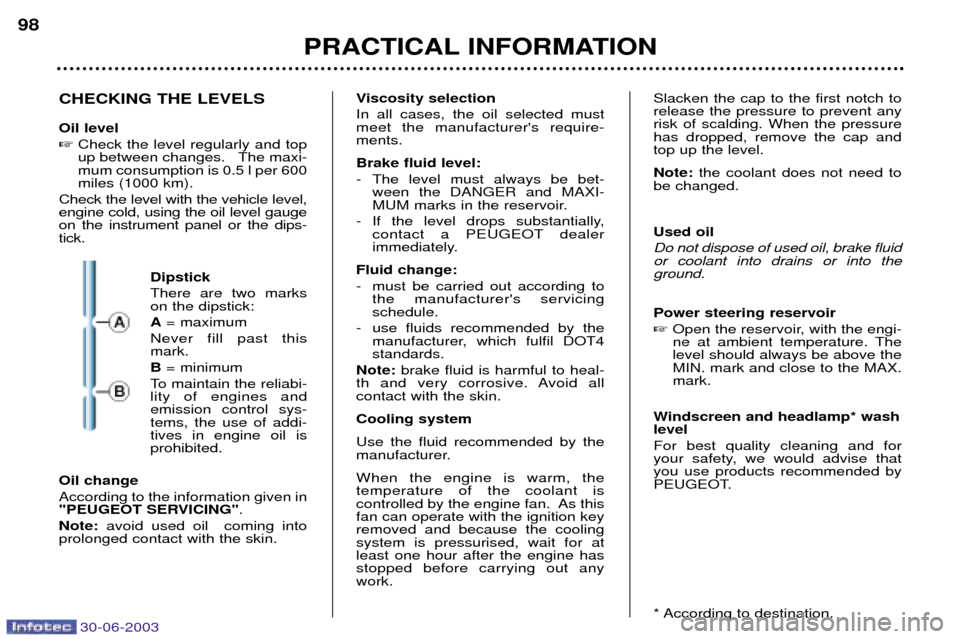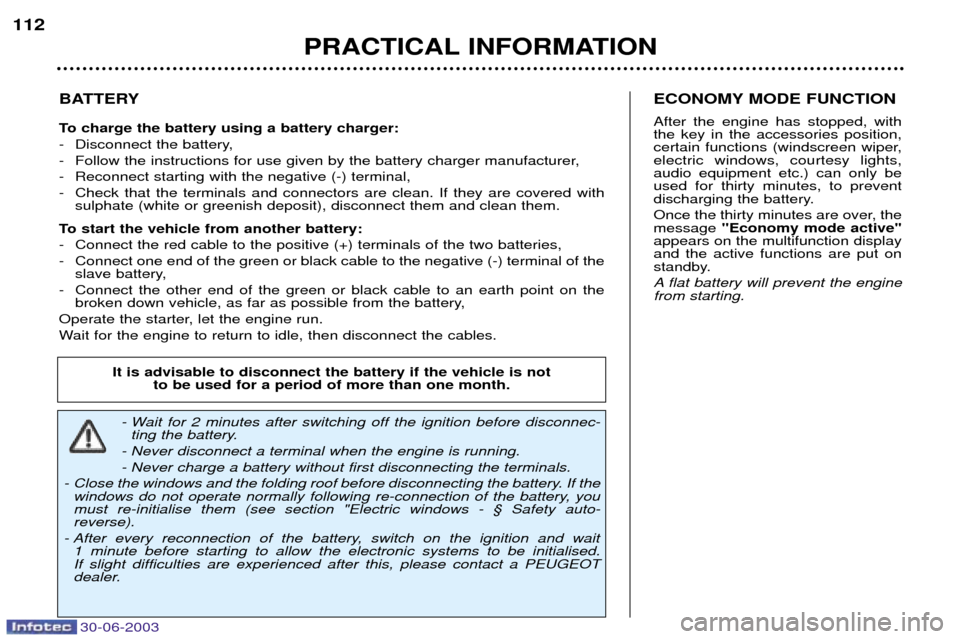Page 101 of 131

30-06-2003
PRACTICAL INFORMATION
98
CHECKING THE LEVELS Oil level �
Check the level regularly and top
up between changes. The maxi-mum consumption is 0.5 l per 600miles (1000 km).
Check the level with the vehicle level,engine cold, using the oil level gaugeon the instrument panel or the dips-tick.
Dipstick There are two marks on the dipstick: A= maximum
Never fill past this mark. B = minimum
To maintain the reliabi- lity of engines andemission control sys-tems, the use of addi-tives in engine oil isprohibited.
Oil change According to the information given in
"PEUGEOT SERVICING" .
Note: avoid used oil coming into
prolonged contact with the skin. Viscosity selection In all cases, the oil selected must meet the manufacturer's require-ments. Brake fluid level:
- The level must always be bet-
ween the DANGER and MAXI-
MUM marks in the reservoir.
- If the level drops substantially, contact a PEUGEOT dealer
immediately.
Fluid change:
- must be carried out according to the manufacturer's servicing schedule.
- use fluids recommended by the manufacturer, which fulfil DOT4standards.
Note: brake fluid is harmful to heal-
th and very corrosive. Avoid allcontact with the skin. Cooling systemUse the fluid recommended by the
manufacturer. When the engine is warm, the temperature of the coolant is
controlled by the engine fan. As thisfan can operate with the ignition keyremoved and because the coolingsystem is pressurised, wait for atleast one hour after the engine hasstopped before carrying out anywork. Slacken the cap to the first notch torelease the pressure to prevent anyrisk of scalding. When the pressurehas dropped, remove the cap andtop up the level. Note:
the coolant does not need to
be changed. Used oil Do not dispose of used oil, brake fluid or coolant into drains or into theground. Power steering reservoir � Open the reservoir, with the engi-
ne at ambient temperature. Thelevel should always be above theMIN. mark and close to the MAX.mark.
Windscreen and headlamp* washlevel For best quality cleaning and for
your safety, we would advise thatyou use products recommended by
PEUGEOT.
* According to destination.
Page 116 of 131

30-06-2003
PRACTICAL INFORMATION
112
BATTERY
To charge the battery using a battery charger:
- Disconnect the battery,
- Follow the instructions for use given by the battery charger manufacturer,
- Reconnect starting with the negative (-) terminal,
- Check that the terminals and connectors are clean. If they are covered with
sulphate (white or greenish deposit), disconnect them and clean them.
To start the vehicle from another battery:
- Connect the red cable to the positive (+) terminals of the two batteries,
- Connect one end of the green or black cable to the negative (-) terminal of the slave battery,
- Connect the other end of the green or black cable to an earth point on the broken down vehicle, as far as possible from the battery,
Operate the starter, let the engine run.
Wait for the engine to return to idle, then disconnect the cables. ECONOMY MODE FUNCTION After the engine has stopped, with the key in the accessories position,
certain functions (windscreen wiper,electric windows, courtesy lights,audio equipment etc.) can only beused for thirty minutes, to prevent
discharging the battery.
Once the thirty minutes are over, the message
"Economy mode active"
appears on the multifunction displayand the active functions are put on
standby.
A flat battery will prevent the engine from starting.
- Wait for 2 minutes after switching off the ignition before disconnec- ting the battery.
- Never disconnect a terminal when the engine is running.
- Never charge a battery without first disconnecting the terminals.
- Close the windows and the folding roof before disconnecting the battery. If the windows do not operate normally following re-connection of the battery, you must re-initialise them (see section "Electric windows - ¤ Safety auto-reverse).
- After every reconnection of the battery, switch on the ignition and wait 1 minute before starting to allow the electronic systems to be initialised. If slight difficulties are experienced after this, please contact a PEUGEOT
dealer. It is advisable to disconnect the battery if the vehicle is not
to be used for a period of more than one month.
Page 119 of 131

30-06-2003
PRACTICAL INFORMATION115
TOWING A TRAILER,
CARAVAN, BOAT etc.
Only use original PEUGEOT tow bars that have been tested andapproved from the design stage of
your vehicle. The tow bar must be
fitted by a PEUGEOT dealer.
Your vehicle is primarily designed for transporting people and luggagebut it may also be used for towing a
trailer. Driving with a trailer subjects the towing vehicle to more significantstress and its driver must beparticularly careful. Air density decreases with altitude, thus reducing engine performance.Above 1000 metres, the maximumtowing load must be reduced by 10% and so on for every 1000 metres of altitude.Driving advice Distribution of loads :
Distribute
the load in the trailer so that the heaviest items are as close as pos-sible to the axle and the nose weightapproaches the maximum permittedwithout exceeding it. Cooling :
Towing a trailer on a slope increases the temperature of the coolant. As the fan is electrically controlled, its cooling capacity is not dependenton the engine speed.
On the contrary, use a high gear to lower the engine speed and reduceyour speed. The maximum towing load on a long slope depends on the gradient andthe outside temperature. In all cases, pay attention to the coolant temperature. If the warning light comes on, stop
the vehicle and switch off the engineas soon as possible. Tyres : Check the tyre pressures of the tow-
ing vehicle and of the trailer, observ-ing the recommended pressures. Braking :
Towing increases the braking distance. Lights : Check the electrical signalling on the
trailer. Side wind :
Take into acount the increased sensitivity to side wind.